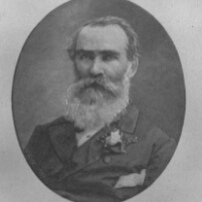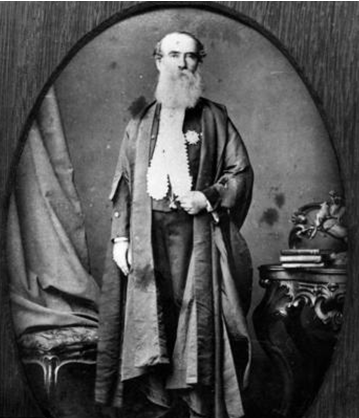Following an illustrious career in the British army, Australian-born Sir Maurice Charles O’Connell (1812 – 1879) commenced a political career. After three years in the New South Wales Parliament, he was appointed Crown Lands Commissioner. At times he served concurrently as Crown Lands Commissioner and as Government Resident of Port Curtis. O’Connell was a controversial figure with a fiery temperament and frequently clashed with other Government officials. When his term as Government resident ended he moved to Brisbane where he served as President of the new Queensland Legislative Council. In 1868 he became the first Queenslander to be knighted by Queen Victoria. O’Connell died in 23 March 1879 in Brisbane.
Maurice Charles O’Connell was born the son of Lieutenant Maurice Charles Philip O’Connell of the 73rd Regiment who had arrived in Sydney aboard the Dromedary with Governor Macquarie in 1809. Shortly after his arrival he had married Mrs Mary Putland, daughter of the fourth Governor of New South Wales, Governor William Bligh. Their son Maurice was born on 13 January 1812. O’Connell senior was later named Commander of the Forces in New South Wales and became Lieutenant Governor of New South Wales in 1846.
With such well-connected parents, the younger Maurice O’Connell seemed destined to play a significant role in the future development of the colony. However, his early years were spent abroad. In 1814 he accompanied his parents to Sri Lanka, formerly Ceylon, where he lived for seven years before being sent to England to study, firstly at Dr. Pinkney’s Academy in Surrey, then at Edinburgh High School, before pursuing military studies in Dublin and Paris.
Following in his father’s footsteps, Maurice enlisted in the British Army as an ensign and then joined the 73rd Infantry at Gibraltar in 1828. He went on to serve in Malta, then in Regiment Headquarters at Jersey. It was there that he married Eliza Emiline LeGeyt in 1835. The same year, Maurice raised a volunteer regiment of the British Legion in County Cork, Ireland. The Regiment was known as the 10th Munster Light Infantry. O’Connell was promoted to the rank of Lieutenant and led his troops to Spain to fight in the Civil War. For his gallantry in action he was mentioned with distinction in despatches and shortly after, at the age of 25, he was given command of the New British Auxiliary Legion in Spain and raised to the rank of Brigadier-General. For his services to Spain he was created a Knight Commander of Isabella, Knight of San Fernando and Knight Extraordinary of Charles III.
Towards the end of 1837 the Legion was disbanded and O’Connell returned to England and served in the 51st and 28th Regiments before being appointed as military secretary to his father in New South Wales. However, when his Regiment was transferred to India in 1842, O’Connell chose to remain in the colony, sell his army commission and become a pastoralist.
Maurice O’Connell’s political career commenced in August 1845 when he was elected to the New South Wales Legislative Council representing the district of Port Philip before it was proclaimed a separate colony. He held this position until June 1848 when he was appointed Crown Lands Commissioner for the newly-proclaimed Burnett Pastoral District on the northern fringes of settlement. Squatters had already taken up land in the area but were not paying licence fees and were not protected by the Native Police. It was imperative therefore, that a government officer be appointed to establish a court house and police station and to oversee the orderly take up of land. O’Connell arrived at a site known as ‘Norton’s Camp’ on the Burnett River and established an administrative centre. This site was formally named Gayndah in 1849.
O’Connell remained in the Burnett District until he was made Government Resident and Police Magistrate for Port Curtis and Leichhardt in 1854. When O’Connell and his family first arrived at Port Curtis, the settlement consisted of a small number of slab huts so the family lived aboard ship for a month while a temporary government residence, consisting of a large marquee with a timber floor, was erected. A permanent residence at Barney Point was not completed until late 1856.
The establishment of Port Curtis, later Gladstone, as an official government post was a move by Governor Charles FitzRoy to ultimately proclaim the township as the capital of a proposed new colony. When the move failed, the blame fell on O’Connell who faced a Select Committee of Inquiry charged with wasting government funds and failing to adequately promote the growth of the region. The position of Government Resident was subsequently abolished but O’Connell remained as Crown Lands Commissioner. In the turmoil of the years leading up to Separation, O’Connell was briefly reinstated as Government Resident to administer the area around Port Curtis during the 1858 gold rush at Canoona but again relieved of the position when Queensland was proclaimed a colony in December 1859. O’Connell was known for his overbearing nature and fiery temperament. He frequently clashed with Francis McCabe who was appointed by the Government to survey the township of Gladstone. However, during his time as Commissioner the region progressed as local businesses were established and communications with other communities improved.
Following his term as Crown Lands Commissioner and Government Resident, O’Connell returned to Brisbane and was appointed as President of the first Queensland Legislative Council on 27 August 1860, a position he retained until his death. As President of the Council he acted as Administrator in the absence of the Governor which occurred on four separate occasions. O’Connell was knighted for his government service in 1868 following the visit of the Duke of Edinburgh to Brisbane. In the same year he had the honour of officially opening Queensland Parliament House even though the building was not completed until 1889. However, O’Connell remained a controversial figure. In 1871 he was accused of accepting a bribe and his worsening financial situation led to the Bank of Queensland taking action against him over unpaid debts incurred on his pastoral properties near the Boyne River.
Apart from his political interests, O’Connell was one of the founders of the Queensland Turf Club having arranged a grant of 322 acres (130 hectares) at Eagle Farm for horse racing. He was also elected provincial Grandmaster of the Freemasons of the Irish Constitution, President of the Australasian Association, President of the Queensland Turf Club, Vice-President of the National Agricultural Association and Colonel of the Queensland Volunteer Brigade.
Sir Maurice O’Connell died of throat cancer on 23 March 1879. At the time he was staying at Parliament House in Brisbane while his home was undergoing renovations. He was buried in the Toowong Cemetery on 25 March 1879 following a funeral service at St. John’s Cathedral.
Citation
Margaret Shield, ‘Maurice Charles O’Connell (1812 – 1879)’, Harry Gentle Resource Centre, Griffith University, 2018, https://harrygentle.griffith.edu.au/life-stories/maurice-oconnell/.
Books
Published in print and online: 23 Sep 2004.
James Francis Hogan, The Gladstone Colony: An Unwritten Chapter of Australian History
London: Fisher Unwin, 1898.
Journals
Maurice Charles O’Connell: a biographical sketch. J. T. Maher. Journal of the Royal Historical Society of Queensland, Vol. 7, No. 2, 1963, pp. 245-262.
Newspapers
Sir Maurice Charles O'Connell , Australian Sketcher with Pen and Pencil , 19 Feb 1876, pp. 183-184.
Sir Maurice O'Connell, President of the Legislative Council of Queensland, The Australian Sketcher with Pen and Pencil, 19 Feb 1876, p. 189.
Sir Maurice O'Connell: Died March 23, Telegraph [Brisbane], 24 Mar 1879, p. 2.
Obituary: Sir Maurice O'Connell, The Week [Brisbane], 29 Mar 1879, p. 21.
General news: The late Sir Maurice O'Connell, The Queenslander, 29 Mar 1879, p. 407.
Online Resources
H. J. Gibney, 'O'Connell, Sir Maurice Charles (1812-1879)', Australian Dictionary of Biography
'Maurice Charles O'Connell (Australian politician)', Wikipedia
'Friend Park, Barney Point', Wikipedia
'Sir Maurice Charles O'Connell', Monument Australia
'O'Connell, Maurice Charles', Former Member Details, Queensland Parliament





